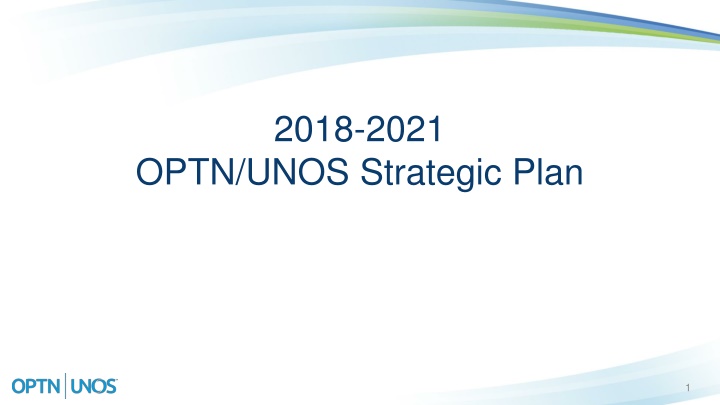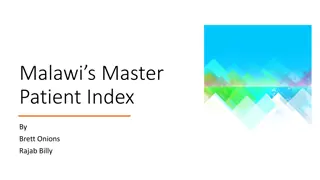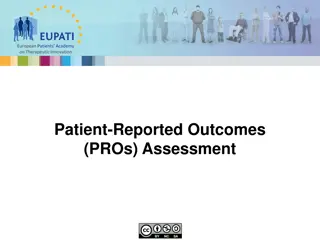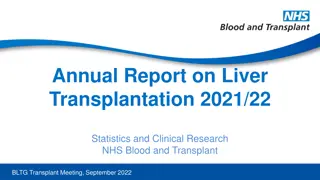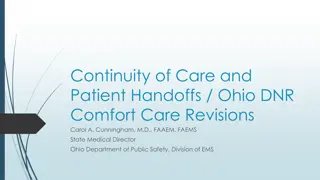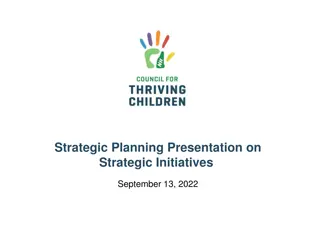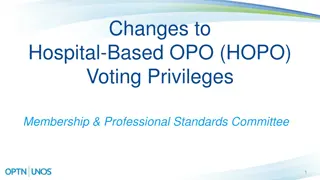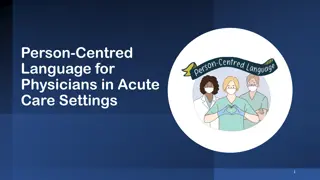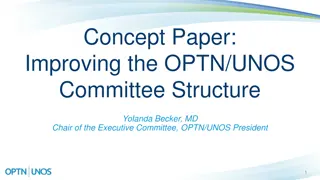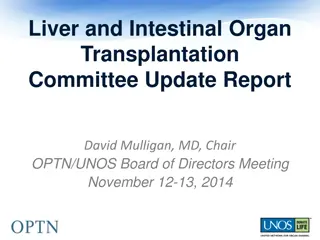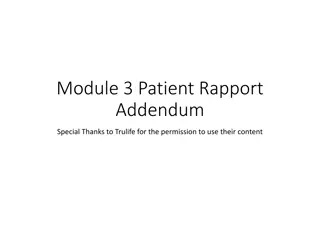OPTN/UNOS Strategic Plan: Enhancing Transplants and Patient Outcomes
The strategic plan for OPTN/UNOS (2018-2021) focuses on increasing the number of transplants, promoting equity in access to transplants, improving patient outcomes, enhancing safety, and efficient management. It outlines initiatives like dynamic donor/recipient matching, collaborative improvement methods, effective donation practices, and analysis of refusals. The plan emphasizes data utilization, technology integration, and providing timely information to improve transplant services.
Download Presentation

Please find below an Image/Link to download the presentation.
The content on the website is provided AS IS for your information and personal use only. It may not be sold, licensed, or shared on other websites without obtaining consent from the author.If you encounter any issues during the download, it is possible that the publisher has removed the file from their server.
You are allowed to download the files provided on this website for personal or commercial use, subject to the condition that they are used lawfully. All files are the property of their respective owners.
The content on the website is provided AS IS for your information and personal use only. It may not be sold, licensed, or shared on other websites without obtaining consent from the author.
E N D
Presentation Transcript
2018-2021 OPTN/UNOS Strategic Plan 1
How was this plan developed? Strategic Planning session with committee chairs and Board members at June 2017 Board Meeting Internal strategic planning group and integration of department goals Direct feedback from the Executive Committee Feedback from the Board members 2
MORE TRANSPLANTS Fair Effective Safe Efficient MATCH DATA QI 3
The OPTN/UNOS brings data and people together. We use technology to make data easier to share and easier to understand, and we deliver information in the time, place, and manner that people can use it best. We are teachers and coaches in evidence-driven efforts to improve performance in our own work and in our members . We automate simple tasks and fully engage our creative analytical capabilities for impactful, behavior-changing work. We are a source of best practices, collegial connections, and the very latest information about how to best serve the patients who are waiting for organ transplants. 4
Plan structure Description of current activities Opportunities for growth Metrics 5
Strategic Plan Resource Allocation Current Proposed Goal Benchmark Goal Benchmark Increase the number of transplants 40% Increase the number of transplants 40% Provide equity in access to transplants 30% Provide equity in access to transplants 30% Improve waitlisted patient, living donor and transplant recipient outcomes Improve waitlisted patient, living donor and transplant recipient outcomes 15% 10% Promote living donor and transplant recipient safety Promote living donor and transplant recipient safety 10% 10% Promote efficient management of the OPTN 5% Promote efficiency in donation and transplant 10% 6
Increase Transplants--Initiatives More dynamic donor/recipient matching transplants arranged through KPD Expand use of collaborative improvement methodologies/models Examine monitoring approaches for tx programs/OPOs for increased collaboration and performance improvement Promote knowledge of effective donation/procurement practices Improve ability to perform analysis of refusals 7
Increase Transplants--Metrics time from OPO first notification to cross clamp date/time in final acceptance of first offer (or within 3 offers) in transplants performed through KPD in utilization from participants in collaborative improvement programs 8
Promote equity--Initiatives Improve equity in opportunities for multi-organ and single-organ candidates geographic disparity diversity on Board/Committees to ensure variety of perspectives in policy development opportunities for volunteer engagement and awareness of OPTN/UNOS volunteer opportunities Improve member and public engagement in policy development Develop equity benchmark for each organ Collect additional data on vulnerable populations 9
Promote equity--Metrics Allocation policies allow for equal transplant opportunities between multi-organ and single organ candidates Volunteers in number and reflect the patients and professionals we serve by 10% in the pool of interested individuals for Board/committee service in median of individuals per cycle participating in public comment Develop an equity measure for each organ, including geographic disparities By 2020, all allocation policy proposals will include discussion of impact on vulnerable populations 10
Improve Outcomes--Initiatives Improve longevity of organ transplants Evaluate effective methods for assessing living donor outcomes Enhance transplant program tools and education in selection and follow up of living donors Expand use of collaborative improvement models to promote effective donor management practices impacting transplant outcomes Develop transplant program tools to calculate survival benefit 11
Improve Outcomes--Metrics By 2021, an in percentage of organ offer types that include a calculator for survival benefit Improved compliance in living donor follow up in waitlist mortality and recipients returning to waiting list 12
Promote safety--Initiatives Improve accuracy in HLA reporting number of safety incidents related to logistics/transport perception of UNOS and MPSC as focused on process improvement Enhance knowledge-sharing about safety events, near misses, and effective practices Enhance system capability for reporting elements of data related to safety 13
Promote safety--metrics in HLA transcription errors in number of logistics and transport-related safety issues in members who respond that peer review process is valuable in process improvement on post-monitoring survey On an annual basis, 20 reported referrals sent from UNOS Member Quality to Instructional Innovations or committees to be addressed through communications or educational offerings 14
Promote Efficiency-- Initiatives Modularize and simplify UNetSM architecture to expedite system changes and improve quality Achieve continuous level of UNet accessibility Improve efficiency in policy development and implementation process Improve volunteer workforce satisfaction and engagement seamless data exchange between members and UNet 15
Promote Efficiency-- Metrics By 2021, UNet is available 99.9% of time in number of projects that are smaller and incrementally delivered Have at least 75% of policy proposals approved by the Board on the non- discussion agenda By 2021, time from Board approval to start of IT project will be max of 3 months By 2021, members can submit 50% of required data through an API By 2020, in percentage of centers downloading reports from data portal 16
Specific Requests for Feedback What is your opinion of this concept? Do you think the OPTN strategic plan contains the right measures to assess progress on the strategic goals? 17
Questions? 18
